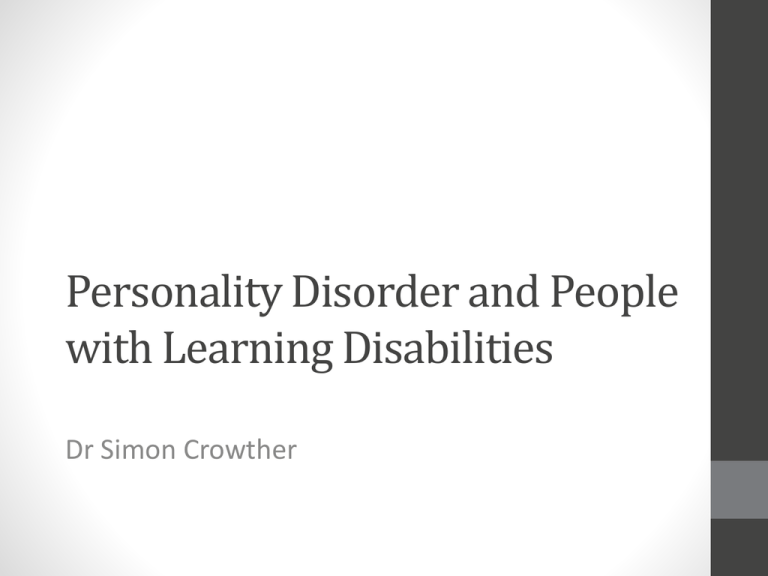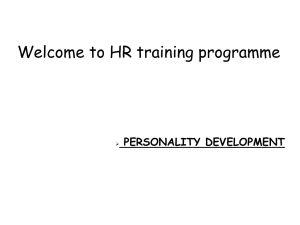Prevalence of PD in LD - Jan
advertisement

Personality Disorder and People with Learning Disabilities Dr Simon Crowther Overview • Personality Disorder (PD) and people with Learning Disabilities (LD) • A model for PD and LD • Case examples • Challenges Personality Disorder (PD) Definition of PD “Deeply ingrained and enduring behaviour patterns, manifesting themselves as inflexible responses to a broad range of personal and social situations.” World Health Organisation 3 P’s model- Persistent, Pervasive and Problematic (DoH, 2012). Prevalence of PD in LD (Alexander et al, 2002) - Community teams- 7% - Secure settings- 50/60% Personality Disorder Clusters Cluster A: Cluster B: Cluster C: Odd and Eccentric Dramatic and Erratic Anxious and Fearful • Schizoid • Paranoid • Schizotypal • Antisocial • Borderline • Histrionic • Narcissistic • Avoidant • Dependent • Obsessive Compulsive Personality Functioning Continuum General Public Healthy Personality Functioning Some Problem Traits Many problem Traits Personality Disorder Offenders Diagnostic Cut-off PD and LD Diagnosing PD in people with LD is a contentious issue… - Assessment problems - Validity problems - More stigma But PD is a clinically important issue… Tor (2008)- diagnosis of ASPD associated with placements in higher security, serious and repeat offending and poorer long term outcomes Alexander et al (2006)- LD offenders with PD discharged from MSU were x9 times more likely to re-offend PD and LD Diagnosis solutions? Only diagnose people with LD in the mild/moderate range (Lindsay et al, 2005). Only diagnose those with ‘cluster B’ Personality Disorder (Naik et al, 2002). PD and LD The initial evidence suggests that interventions beneficial for people without LD can also be helpful for people with LD… • Cognitive Analytic Therapy (CAT)- Lloyd & Clayton (2013) • Dialectical Behaviour Therapy (DBT)- Morrissey & Ingamells (2012), Brown et al (2014). • Therapeutic Communities (TCs)- Taylor & Morrissey (2012), Taylor et al (submitted). PD and LD In the literature on working with people with PD two themes are prominent: 1. That the environment around the person is supportive, healthy and enabling (MoJ) 2. The importance of delivering treatment in an integrated and coordinated manner- John Livesley (2003) What works with PD For people with a diagnosis of PD their difficulties exist in their relationships with others. Healthy and supportive relationships are crucial to treatmentbut this is easier said than done! Current relationships and interactions are a focus of the treatment approach. Every interaction, from the mundane to the emotionally charged, is an important opportunity for reflection and learning. What works with PD? (Livesley, 2003) 5% Person Interactions Therapy 45% 50% PD treatment framework Principles Engagement and Assessment ‘Team’ approach All members of the team have a role Formulation and Goal setting Formulation and goal setting as central Treatment Enabling Environment Moving on First 3-6 months in the PD care pathway 12-18 months in the care pathway Principles of the approach • An ‘enabling environment’ • Use of psychological formulation to understand complex behaviour and risk. • Whole team philosophy • Training and support for the staff team An ‘Enabling Environment’ Psychologically Informed Planned Environments (PIPEs). (NOMS & DoH, 2012). • An emphasis is placed on the importance and quality of relationships. • Staff are provided with further training to have an increased psychological understanding of their work and of complex behaviour. • Service structures aim to promote healthy relationships and offer opportunities to work through relationship difficulties. An ‘Enabling Environment’ Development of psychological psychological formulations thinking ‘Every interaction matters’ Occupational therapy sessions structure the day. Social participation and group activities . Personal responsibility and self-efficacy through Psychological Formulation All clients are offered a formulation as part of the assessment process. Two types of formulation are used in this service… Case formulation- to develop an understanding of the key relationship problems that we need to support the person with. Risk formulation-to develop an understanding of key risk behaviours, how this might play out with others and what support is needed to minimise this. Psychological Formulation Case formulations PD as PTSD- re-enacted in current relationships Formulations aim to make sense of overwhelming and confusing behaviour. Formulation as a support guide for staff team and to suggest most appropriate interventions. Formulations should predict difficulties in engagement. Psychological Formulation Risk Formulations The key risk areas assessed using a structured professional judgement assessment. (SPJ)- HCR 20 v3, RSVP, etc. Service user involvement in the process. Should identify strengths and protective factors. Should lead to prediction of how the behaviour could happen in current context and a mitigation plan. Whole team philosophy A ‘core team’ for each service user- i.e. service user-key workercase manager-MDT. Shared goals that everyone works towards achieving. A shared understanding of the service user that everyone uses. A belief in the team approach, including an ability to work democratically and consistently. The use the communication forums to resolve conflict and disagreements. The staff team A different role from what they may be used to. Helping the staff team understanding of their work. develop a psychological The importance of regular and consistent support sessions. A ‘culture of curiosity’ and reflective practice. ‘Ad hoc’ supervision. PD- integrating treatment Safety Containment • The safety of self and others • Containment of emotional and behavioural instability Control and Regulation • Reducing symptoms and improving coping skills Exploration and Change • Changing beliefs, behaviour and interpersonal style Integration and Synthesis • Developing a more adaptive lifestyle PD- integrating treatment Safety Containment • Engagement, structure, supervision, formulations • Motivational work, goal setting, communications skills Control and Regulation • Skills based approaches • Improving coping strategies Exploration and Change • Exploratory therapy • Offence focused therapy Integration and Synthesis • Relapse prevention planning • Increased community presence MSU LSU Case examples… ‘Mark’ ‘John’ Rage against women and ‘the system’ Controlling e.g. offending, rule breaking, challenging authority Controlled “I have to be in control.” Using anger to get what I want Minimizing any problems Just focusing on the positives Abusing Angry Abused Hurt Child Abused/Damaged No-one cares about me. Can’t trust anyone. Push others away. Blame others Rejecting Cut off Admiring Admired Overwhelming feelingsUsing drugs, alcohol and pornography and self harm Rejected ‘Mark’- working with the staff team Goal 1- Acknowledging my risk e.g. being able to talk about the risk I could present in the future and how I am going to manage this. I find it hard to talk about my risk of reoffending. I don’t like thinking about it because it makes me feel bad, and instead I try and focus on the positives. I also worry that talking about my risk of reoffending will make others feel worried and that they might keep me here longer. However, I will need to be able to talk about risk so that people feel confident that I can manage this in the future. Rating- 5/10 ‘Mark’- working with staff team Plan for Goal 1 1. Engage in therapy work regarding sexual feelings. 2. To start to talk to trusted others about my risk of reoffending. 3. To try and not be defensive when others talk about my risk. Evidence of progress…. Signs that I am in this place BATTLING Punishing, Attacking I shout, threaten and pace up and down. I make complaints and threaten to get people sacked Look out for people taking the ‘p*ss’ Punished, Hurt, Angry I refuse to ‘back down’ Others ‘punish and control me’ Which make me think I need to be in control of myself and others Painful feelings from childhood- Signs that I am in this place I use intimidation and threats to get what I want I ‘look out’ for people ‘taking the p*ss’ I start to feel fed up and unfairly treated and think- F*ck it! I should be able to have whatever I want!” GETTING A BUZZ Abusing/ Rule breaking Asking for things that I won’t get/are unrealistic Abused “ALTER EGO” Controlling Signs that I am in this place ‘Sneaking around’/changes to my usual routine Signs that I am in this place I put my needs first Not being open about my feelings Becoming defensive when talking about risk I keep other people at a distance Controlled Weak, Vulnerable Punished Others get worried, and punish/ control me’ which makes me think I need to be in control of myself and others John- working with the staff team Goal 2 To cope with feeling frustrated, disappointed or let down When I feel frustrated, disappointed or let down I can ‘go off on one’, becoming angry very quickly and making threats towards others. Rating- 2/10 John- working with the staff team Plan for Goal 2 (a) To practice coping strategies when I feel like this- and to learn coping strategies for this if I don’t have any (b) To stop myself from ‘punishing’ people when I have these feelings. (c) To repair relationships when I have punished or threatened others. Evidence of progress…. John- working with the staff team Goal 4 To show care and support to others I find it hard to think about others, and put my needs first. When my behaviour has an impact on others I can say things like, “I don’t care about anyone others than myself”. Rating- 1/10 John- working with the staff team Plan (a) To put other people first sometimes (b) To make compromises with others (c) To show support for people I live with (d) To think about how other people feel Evidence of progress… Challenges It can be emotionally intense. Low motivation, hopelessness and despair is common. Training and supervision is vital. It takes time to set up services and for people to feel comfortable working this way. The treatment pathway through services for people with LD and PD needs further development (and funding!)… Working with people with PD “Providing effective care and treatment for people with personality disorder is one the most challenging in the field of mental health…but…working with this client group can provide staff with a tremendous sense of job satisfaction and growth” (Murphy and McVey, 2010) References Alexander, R., T., Piachaud, J. Odebiyi, L. & Gangadharan, S., K. (2002). Referrals to a forensic learning disability, British Journal of Forensic Practice, 4, 29-33. Alexander, R. T., Crouch, K., Halstead, S. & Piachaud, J. (2006). Longterm outcomes from a medium secure unit for people with intellectual disability, Journal of Intellectual Disability Research, 50, 305-15. Alexander, R. T., Green, F., N., O’Mahony, B., Gunarantna, J., I., Gangadharan, S., K. & Hoare, S. (2010). Personality disorders in offenders with intellectual disability: a comparison of clinical, forensic and outcome variables and implications for service provision, Journal of Intellectual Disability Research, 54. 650-658. Lindsay, W.R., Gabriel, S., Dana L., Young, S. & Dosen, A. (2005). Personality Disorders. In: Diagnostic Manual of Psychiatric Disorders for Individuals with Mental Retardation, National Association for Dual Diagnosis, Kingston, NY. References Livesley, J. (2003). Practical Management of Personality Disorder, Guilford Press. Lloyd, J. & Clayton, P. (2013) .Cognitive Analytic Therapy for People with Intellectual Disabilities and their Carers, Jessica Kingsley. Murphy, N. & McVey, D. (2010). Treating Personality Disorder: Creating Robust Services for People with Complex Mental Health Needs. Morrissey, C. Taylor, J. & Bennett, C. (2012). Evaluation of a therapeutic community intervention for men with intellectual disability and personality disorder, Journal of Learning Disability and Offending Behaviour, 3, 52-60. Morrissey, C. & Ingamells, B. (2011). Adapted dialectical behaviour therapy for male offenders with intellectual disability in a high secure environment: six years on, Journal of Learning Disabilities and Offending Behaviour, 2, 10-17. References Naik, B., I., Gangadharan, S., K. & Alexander, R., T. (2002). Personality disorders in learning disability- the clinical experience. British Journal of Developmental Disabilities, 48, 95100. Taylor, J. & Morrissey, C. (2012). Integrating treatment for offenders with an intellectual disability and personality disorder, The British Journal of Forensic Practice, 14. 302-315. Taylor, J., Crowther, S., Sothern, C., & Stronach, C. (submitted). Therapeutic Communities for People with Intellectual Disability and Complex Needs, Advances in Mental Health and Intellectual Disabilities.









